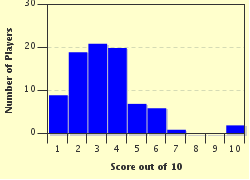Quiz Answer Key and Fun Facts
1. The common cuckoo (see photo) employs various strategies to get the host to raise the cuckoo's offspring. Which of the following techniques is NOT used?
2. The life cycle of the lancet liver fluke typically involves a grazing animal (such as a cow or a sheep), a snail and an ant. The ant is 'persuaded' to climb to the end of a piece of grass in order to be eaten. How?
3. The endangered snuffbox mussel (see photo) is found in the Great Lakes and Mississippi River system of North America. A freshwater fish, the common logperch, plays a key role in the reproductive cycle of the mussel. How?
4. Most barnacles sit on rocks. This particular one, the Anelasma squalicola, has chosen a mobile platform. Which cartilaginous predator has it ended up on?
5. When you next catch a red snapper, you might want to check it for a passenger. What body part is replaced by the Cymothoa exigua parasite, a type of louse?
6. Cats and rats generally have a hunter-prey relationship. However, the parasitic protozoan known as Toxoplasma gondii alters the behaviour of the rat to make it more likely to be caught. How?
7. The nematode Heterorhabditis bacteriophora uses bacteria to kill and digest its host. What defence mechanism is used to ward off larger predators while the nutrients from the host are consumed?
8. Hyperparasitoids are parasites that prey on parasites. The wasps of the genus Trigonalidae fall into this category. They lay thousands of tough, minuscule eggs on leaf edges or in the leaf itself, which are then eaten by a passing caterpillar. What is their target prey?
9. The green-banded broodsac is a parasitic flatworm with a songbird as its host. It uses the Succinea snail as an intermediate host. How does it close the loop and make the snail attractive to eat?
10. A Costa Rican parasitoid wasp targets a social spider (see photo) in order to raise its young. It temporarily paralyses the spider and deposits an egg. In due course the larva takes control of the spider to do what?
Source: Author
suomy
This quiz was reviewed by FunTrivia editor
rossian before going online.
Any errors found in FunTrivia content are routinely corrected through our feedback system.

